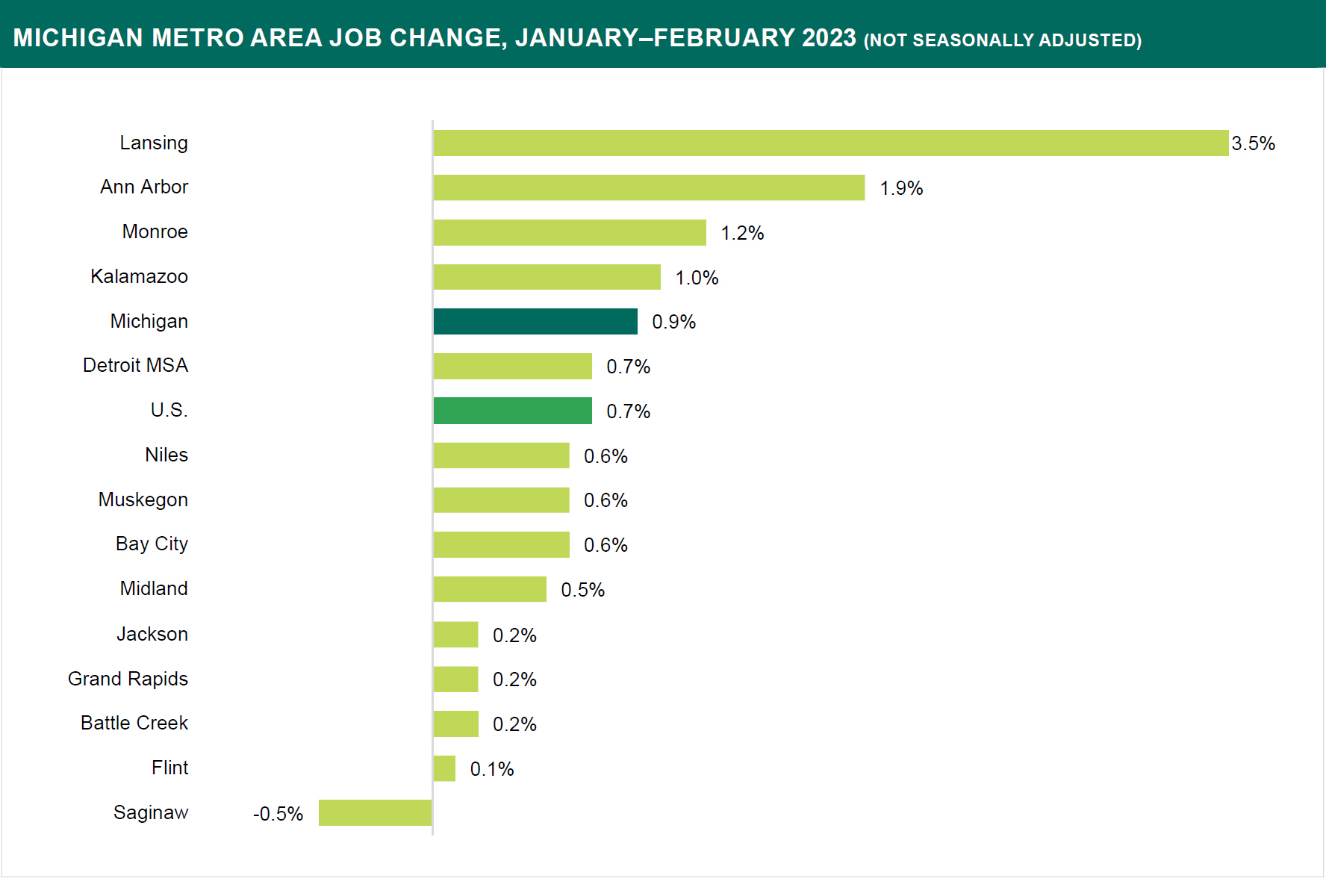
February Data - April Reporting
MICHIGAN UNEMPLOYMENT RATE CONSTANT IN JANUARY AND FEBRUARY
Michigan’s seasonally adjusted unemployment rate remained unchanged for the third consecutive month, at 4.3 percent during February.
The U.S. unemployment rate increased by two-tenths of a percentage point between January and February to 3.6 percent. Michigan’s jobless rate was 0.7 percentage points larger than the U.S. rate. Over the year, the national unemployment rate receded by two-tenths of a percentage point, while the statewide rate rose by one-tenth of a percentage point. Compared to other states, Michigan’s 4.3 percent unemployment rate was tied with California for 7th highest nationally.
Michigan’s labor force was nearly unchanged during February, with a workforce increase of 0.1 percent over the month. The national labor force rose by 0.3 percent since January. Employment edged up by 0.2 percent in the state and 0.1 percent nationally. Total unemployment in Michigan fell by 1.0 percent over the month, while national unemployment advanced by 4.3 percent.
Over the year, Michigan’s workforce advanced by 0.4 percent, 1.1 percentage points below the national labor force increase of 1.5 percent. Statewide employment edged up by 0.3 percent, while the U.S. employment total rose by 1.7 percent. Michigan’s unemployment level increased by 2.5 percent over the year, while national unemployment receded by 5.4 percent.
Michigan 2022 Revised Annual Average Unemployment Rate Decreases Slightly
As a result of the annual benchmarking process, Michigan’s 2022 annual average unemployment rate was revised downward by one-tenth of a percentage point to 4.2 percent. Michigan annual employment rose by 131,000, or 2.9 percent, between 2021 and 2022, while annual unemployment fell by 75,000, or 27.0 percent. The statewide annual labor force advanced by 1.2 percent over the year. Michigan’s annual average unemployment rate fell from 5.8 percent to 4.2 percent, a decrease of 1.6 percentage points between 2021 and 2022.
SHIBANI PUTATUNDA
Economic Specialist

Source: Local Area Unemployment Statistics, Michigan Center for Data and Analytics, Michigan Department of Technology, Management & Budget

Source: Local Area Unemployment Statistics, Michigan Center for Data and Analytics, Michigan Department of Technology, Management & Budget
MICHIGAN JOB TRENDS BY INDUSTRY SECTOR
Monthly Overview
Michigan total nonfarm payroll jobs moved up by 0.3 percent (+14,600) to 4,416,400 in February, on a seasonally adjusted basis. Total payroll employment in Michigan has now risen four consecutive months and 21 times over the month within the past two years. Additionally, job gains on the statewide level rose at a faster rate this month than the previous three months. As of February 2023, statewide employment was only 0.7 percent or 33,100 below its February 2020 pre-pandemic job level.
On the nationwide level, total nonfarm payroll jobs increased over the month by 0.2 percent or 311,000, slightly less than the statewide rate of change. Nationally, seasonally adjusted job gains have now been recorded for the past 26 months, surpassing its February 2020 pre-pandemic job level for the ninth time, with the last recorded nonfarm job decline occurring in December 2020.
On a percentage basis, noteworthy job additions were recorded within several major industry sectors including Leisure and hospitality (+0.9 percent), Other services (+0.7 percent), and Government (+0.6 percent), during February. Additionally, more modest gains were noted over the month within both the Manufacturing and Trade, transportation, and utilities (+0.5 percent) sectors. Numerically, the Trade, transportation, and utilities (+4,000) and Leisure and hospitality (+3,800) industries recorded the most significant employment advances, mainly due to notable job increases within their respective subsectors, during February.
Continued job gains among many Michigan industry sectors and subsectors have moved their respective job levels above February 2020 job counts. The majority of major industry sectors recorded employment levels above their February 2020 job counts except for Manufacturing, Education and health services, Leisure and hospitality, other services, and Government.
Over-the-Year Analysis
Over the year, total nonfarm payroll jobs in Michigan increased by 91,700 or 2.1 percent since February 2022, notably lower than the national average (+2.9 percent) over the same period. Most major industry sectors recorded yearly job gains. Strong employment advancements occurred within several major industries including, Mining and logging (+5.8 percent), Leisure and hospitality (+5.3 percent), Information (+4.3 percent), and Construction (+4.1 percent). Numerically, solid job additions were led by the Government (+22,700) and Leisure and hospitality (+20,800) sectors.
JIM BIRNEY
Economic Analyst

Source: Current Employment Statistics, Michigan Center for Data and Analytics, Michigan Department of Technology, Management & Budget
Annual Benchmark Revision Process Adds Jobs to 2022
In partnership with the U.S. Bureau of Labor Statistics, Michigan recently completed its annual benchmark processes for all its state and metro industry series. The newly revised, benchmarked data was reviewed from the second quarter of 2021 through the third quarter of 2022. These data derived principally from the Quarterly Census of Employment and Wages program, which counts jobs covered by the unemployment insurance tax system. In addition, the basis for industry classification in the establishment survey has been revised from the 2017 North American Industry Classification System (NAICS) to NAICS 2022. Furthermore, for the 2022 benchmark, new seasonally adjusted data for series without historical corrections were adjusted back through 2018. Those series with historical corrections will have seasonally adjusted data updated back to the earliest year affected by historical correction.
The total nonfarm employment level for March of 2022 was revised upward by +14,506 or 0.34 percent. Between March 2021 and March 2022, the seasonally adjusted total nonfarm payroll over the year job growth was revised upward from +172,256 to +186,571. On a monthly basis total nonfarm payroll benchmark revisions ranged from -0.13 percent to +0.93 percent, on the statewide level. On the metro area level, total nonfarm payroll benchmark revisions ranged from -2.02 percent (during February 2022 in Ann Arbor) to +5.47 percent (during August 2022 in Midland). At 1.30 percentage points, the Detroit-Livonia-Dearborn area recorded the smallest range of revisions among all Michigan regions. Conversely, at 5.47 percentage points, the Midland region noted the largest range of revision among all Michigan metro areas.
Metropolitan Statistical Areas (MSAs)
Every Michigan Metropolitan Statistical Area (MSA) recorded not seasonally adjusted job gains over the month besides the Saginaw MSA (-0.5 percent). Only four of those 13 metro areas recorded job gains larger than the state’s rise (+0.9 percent) in February.
Job growth in the Detroit MSA noted the same percent growth as the nation (+0.7 percent) this month. The 3.5 percent increase in jobs in the Lansing MSA was well above other regions primarily due to state government educational services recovering jobs lost in January.
Manufacturing, Information, and Other services jobs remained mostly unchanged in a majority of Michigan’s metro areas during February. Conversely, most metro areas in Michigan noted job additions within their respective Professional and business services sectors. Furthermore, employment in the Government sector recorded typical seasonal job gains in virtually every statewide region.
JIM BIRNEY
Economic Analyst

Source: Current Employment Statistics, Michigan Center for Data and Analytics, Michigan Department of Technology, Management & Budget

Source: Current Employment Statistics, Michigan Center for Data and Analytics, Michigan Department of Technology, Management & Budget
FEBRUARY JOB ADVERTISEMENTS DECLINE
There were 176,300 total job advertisements in the month of February. Of these, 69,500 were new job postings, which indicates they first appeared in February and did not carry over from previous months. This was a slight decrease (-1.6 percent) from January, which had 179,200 total ads. Additionally, this was a 25.8 percent decrease from one year ago in February 2022, which had 237,700 total advertisements. This marks the fourth consecutive month of decline in online job advertisements.
Education
Most of the online job ads in February required a minimum education level of high school diploma or equivalent, with 52,800 advertisements (47.9 percent). The next most advertised minimum education level was for those with a bachelor’s degree, with 41,000 total ads (37.2 percent). Notably fewer employers were advertising for positions that require an associate degree, with just 10,500 ads (9.5 percent). Lastly, the fewest number of job ads required a minimum education level of master’s degree or higher, with just 5,900 ads (5.3 percent).

Disclaimer
The Above Information was created and disseminated by the Department of Technology, Management, and Budget and the Bureau of Labor Market Information and Strategic Initiatives from the State of Michigan. Specialized Staffing does not hold any rights or ownership to this content. For more information, please contact your Michigan Bureau of Labor Representative.
